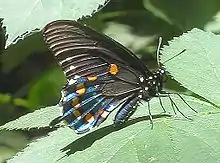| Battus philenor hirsuta | |
|---|---|
 | |
| Scientific classification | |
| Kingdom: | |
| Phylum: | |
| Class: | |
| Order: | |
| Family: | |
| Tribe: | |
| Genus: | |
| Species: | |
| Subspecies: | B. p. hirsuta |
| Trinomial name | |
| Battus philenor hirsuta Skinner, 1908[1] | |
Battus philenor hirsuta, the California pipevine swallowtail or hairy pipevine swallowtail, is a subspecies of the pipevine swallowtail that is endemic to Northern California in the United States. The butterfly is black with hindwings that have iridescent green-blue coloring above and a row of red spots below; the caterpillars are black with fleshy protrusions and orange spots. This subspecies is smaller in size, hairier, and lays eggs in larger clutch sizes than the nominate subspecies.[2][3] The egg clutches are deposited on the shoot tips of the California pipevine, a perennial vine native to riparian, chaparral, and woodland ecosystems of the California Coast Ranges, Sacramento Valley, and Sierra Nevada foothills. The larvae feed exclusively on the foliage and shoot tips of the pipevine, although adults eat floral nectar from a variety of plants.[2][4][5][6] The plant contains a toxic substance, aristolochic acid. The larvae sequester the toxin, and both the juvenile and adult butterflies have high and toxic concentrations of the aristolochic acid in their tissues. Throughout the range of the species, Battus philenor, other butterflies and moths mimic the distinctive coloration of the swallowtail to avoid predators. However, there are no known mimics of the Californian subspecies.[7]
Distribution and habitat
Populations of the California pipevine swallowtail are found throughout the Sacramento Valley and outside of the valley in Contra Costa and Alameda counties. These populations are isolated from other pipevine swallowtail populations, making it a separate subspecies.[8]
Return to San Francisco
The species' presence was drastically reduced in San Francisco, but was being brought back as of 2017, through efforts mainly attributed to Tim Wong, an aquatic biologist at the California Academy of Sciences.[9][10] He gathered caterpillars from nearby areas and raised them in his backyard. He also used the butterflies he raised to repopulate the San Francisco Botanical Garden.[9][10]
References
- ↑ "ITIS Battus philenor hirsuta". Retrieved 30 August 2013.
- 1 2 Richard E. Warner, Kathleen M. Hendrix, ed. (1984). California Riparian Systems: Ecology, Conservation, and Productive Management. p. 937. ISBN 0520050355.
- ↑ Brock, Jim P.; Kaufman, Kenn (2003). Butterflies of North America. New York City, NY: Houghton Mifflin Company. p. 26. ISBN 0-618-15312-8.
- ↑ Von Tilden, J W (1966). Butterflies of the San Francisco Bay Region. University of California Press. p. 54. ISBN 0520012682.
- ↑ "Jepson Flora Project: Aristolochia californica". Regents of the University of California. Retrieved 30 August 2013.
- ↑ Fordyce, James A.; Anurag A. Agrawal (2001). "The role of plant trichomes and caterpillar group size on growth and defence of the pipevine swallowtail Battus philenor". Journal of Animal Ecology. Blackwell Science Ltd. 70 (6): 997–1005. doi:10.1046/j.0021-8790.2001.00568.x.
- ↑ Fordyce, James A. (2000). "A model without mimic: Aristolochic acids from the California pipevine swallowtail, Battus philenor hirsuta, and its host plant, Aristolochia californica". Journal of Chemical Ecology. 26 (11): 2567–2578. doi:10.1023/a:1005588829864. S2CID 22566265.
- ↑ "California Pipevine Swallowtail (U.S. National Park Service)". www.nps.gov. Retrieved 2020-11-12.
- 1 2 "'Butterfly Whisperer' Leads Rare Species' Comeback In San Francisco". 2017-05-07. Retrieved 2020-11-12.
- 1 2 Crockett, Zachary (2016-07-06). "How one man repopulated a rare butterfly species in his backyard". Vox. Retrieved 2020-11-12.